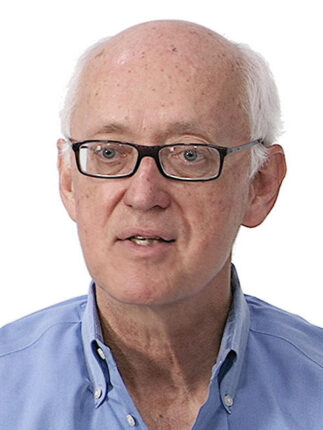

Steven Bernasek
Contact:
Steven Bernasek
Professor of Chemistry, Emeritus; Senior Chemist
[email protected]
Frick Laboratory, 393
609-258-4968
Research Focus
 We are interested in the detailed mechanisms of reactions occurring at surfaces and interfaces. How chemical reactions take place at the gas-solid, liquid-solid, and solid-solid interface forms the focus of our research. An understanding of this chemistry is inherently interesting because of the typical complexity of reactions at a surface or interface, and because interfacial processes are crucial in so many important technological applications. Surface reactions form the core of heterogeneous catalytic processes. The construction of electronic devices relies on an understanding of the surface chemistry of silicon and other inorganic semiconductors. The development of organic electronic devices relies on a detailed understanding of the attachment of organic molecules to silicon surfaces, as well as an understanding of the organic-organic interfaces that comprise typical thin film organic electronic devices. Even applications as common as corrosion inhibition rely on an understanding of the surface oxidation of materials and their interactions with molecular systems.
We are interested in the detailed mechanisms of reactions occurring at surfaces and interfaces. How chemical reactions take place at the gas-solid, liquid-solid, and solid-solid interface forms the focus of our research. An understanding of this chemistry is inherently interesting because of the typical complexity of reactions at a surface or interface, and because interfacial processes are crucial in so many important technological applications. Surface reactions form the core of heterogeneous catalytic processes. The construction of electronic devices relies on an understanding of the surface chemistry of silicon and other inorganic semiconductors. The development of organic electronic devices relies on a detailed understanding of the attachment of organic molecules to silicon surfaces, as well as an understanding of the organic-organic interfaces that comprise typical thin film organic electronic devices. Even applications as common as corrosion inhibition rely on an understanding of the surface oxidation of materials and their interactions with molecular systems.
Our research is directed towards obtaining a fundamental understanding of the detailed mechanisms of these sorts of processes, with an eye towards the impact of this understanding on application.
We approach these interfacial reaction systems primarily from an experimental point of view. Our work relies on obtaining molecular/atomic level information about the structure of surfaces and interfaces, and coupling this structural information with detailed kinetic and mechanistic information obtained using a range of spectroscopic probes. Structural information is obtained using low energy electron diffraction, X-ray diffraction, electron microscopy or scanning probe microscopies, such as scanning tunneling microscopy (STM) or atomic force microscopy (AFM). Electron spectroscopies, such as UV and X-ray photoelectron spectroscopy, and high resolution electron energy loss spectroscopy (HREELS), as well as optical probes such as reflection absorption infrared spectroscopy and surface enhanced Raman spectroscopy allow us to obtain surface composition and molecular level structural information about the surfaces and interfaces that we study. Electrochemical probes, such as cyclic voltammetry and electrochemical impedance spectroscopy, are used to study the kinetics of these processes at the liquid-solid interface. Mass spectrometry and molecular spectroscopy are used to probe kinetics and dynamics of reactions at the gas-solid interface.
Examples of some of our recent studies of reactions at the liquid-solid interface and at the gas-solid interface, to illustrate our approach to understanding surface and interface chemistry:
Several of the key questions which must be addressed for the eventual implementation of thin film organic electronic and opto-electronic devices fashioned inexpensively using solution processing approaches are related to the detailed mechanism of self-assembly of organic molecules at the liquid-solid interface. We have used STM to probe the molecular level structure of self-assembling monolayers of organic molecules formed at graphite surfaces from solution. Structures are obtained by scanning directly at the liquid-solid interface. We are attempting to develop an understanding of the balance between adsorbate-adsorbate and adsorbate-substrate interactions, along with the effect of adsorbate-substrate geometric registry which causes particular self-assembled morphologies and nanostructures to form. Understanding these structural motifs and their stabilities, and the design rules based on these observations, could lead to an improvement of the structure dependent electronic properties of these self-assembled layers utilized in organic electronic devices. Chemical reactions occurring at electrode surfaces, in particular the electrocatalytic reduction of CO2 to form fuels and value added chemicals, is another focus of our research at the liquid-solid interface. In this instance, electrochemical probes are coupled with vacuum based photoelectron spectroscopy to provide a detailed understanding of the interaction of CO2 and catalyst molecules, such as imidazole with electrode surfaces under aqueous conditions. This work also informs mechanistic studies of corrosion inhibition at active metal surfaces such as iron and copper using these same sorts of pyridine and substituted imidazole molecules in the presence of dissolved CO2.
Examples of our studies at the gas-solid interface address problems of materials for energy production application and studies focused on the dynamics of catalytic oxidation reactions. In collaboration with scientists at the Princeton Plasma Physics Laboratory and the School of Engineering and Applied Science, we have been examining the surface chemistry of candidate first wall materials for application in fusion reactors. In particular, we have been using the tools of surface science to examine the mechanisms of reaction of small molecules such as water, CO, H2, and CO2 with reactive lithium surfaces supported on graphite or refractory metal substrates. This low Z material appears to be a promising plasma-facing first wall material. However, more must be known about its reaction chemistry with the residual gas molecules present in the fusion reactor under operating conditions before it can be properly engineered to be used as this first wall material. We are using HREELS, photoelectron spectroscopy and Auger electron spectroscopy to examine the kinetics and mechanisms of these interactions.
Another energy related gas-solid system which we have studied for a number of years is the detailed mechanism of the heterogeneous catalytic oxidation and partial oxidation of small molecules ranging from CO, to methanol and ethanol, and one and two carbon acids and aldehydes. We examine these reactions in two flow reactor systems. One examines the dynamics of these surface reactions, by probing the internal energy distribution in the product CO2 molecule. The other flow system focuses on the identification of adsorbates and reaction intermediates directly on the catalyst surface using nanoplasmonic sensor based optical spectroscopy. In both cases, the specific focus information is coupled with kinetic information about the reaction obtained using mass spectrometric probing of the flow reactor output.
Honors
KOSMOS Fellow, Humboldt University-Berlin (2014-2015)
Alexander von Humboldt Foundation Research Fellow (1985-1986, 1990, 2007)
ACS Arthur W. Adamson Award for Distinguished Service in the Advancement of Surface Chemistry (2006)
Fellow of the American Vacuum Society (2001)
Distinguished Visiting Professor, National University of Singapore (1998-present)
Visiting Fellow, JILA, University of Colorado (1999)
ACS-Exxon Award in Solid State Chemistry (1981)DuPont Young Faculty Grant (1977)
National Science Foundation Graduate Fellow (1971-1975)
Selected Publications
Frederick, E.; Dickerson, P. N.; Zhong, Y. L.; Bernasek, S. L., “Substituent Effects on the Kinetics of Bifunctional Styrene SAM Formation on H-Terminated Si.” Langmuir 2014, 30 (26), 7687-7694.
Detweiler, Z. M.; White, J. L.; Bernasek, S. L.; Bocarsly, A. B., “Anodized Indium Metal Electrodes for Enhanced Carbon Dioxide Reduction in Aqueous Electrolyte.” Langmuir 2014, 30 (25), 7593-7600.
Hibberd, A. M.; Seltzer, S. J.; Balabas, M. V.; Morse, M.; Budker, D.; Bernasek, S. L., “Light-induced changes in an alkali metal atomic vapor cell coating studied by X-ray photoelectron spectroscopy.” Journal of Applied Physics 2013, 114 (9).
Bernasek, S. L., “Molecular electronics Van der Waals rectifiers.” Nature Nanotechnology 2013, 8 (2), 80-81.
Hibberd, A. M.; Bergman, S. L.; Zhong, Y. L.; Bernasek, S. L., “Potassium spin polarization lifetime for a 30-carbon chain siloxane film.” Journal of Chemical Physics 2012, 137 (17).
Hibberd, A. M.; Thorman, R. M.; Wnuk, J. D.; Bernasek, S. L., “Rb deposition on alkanethiolate monolayers on Au.” Journal of Applied Physics 2012, 112 (2).
Bernasek, S. L., “Can We Understand the Molecule in Molecular Electronics?” Angewandte Chemie-International Edition 2012, 51 (39), 9737-9738.
Zhong, Y. L.; Bernasek, S. L., “Mild and Efficient Functionalization of Hydrogen-Terminated Si(111) via Sonochemical Activated Hydrosilylation.” Journal of the American Chemical Society 2011, 133 (21), 8118-8121.
Tao, F.; Bernasek, S. L., “Thermally Driven Switch of Binding Configuration of 3-Pyrroline on Si(111)-7 x 7.” Journal of Physical Chemistry C 2011, 115 (5), 2020-2025.
Zhong, Y. L.; Bernasek, S. L., “Direct Photochemical Functionalization of Si(111) with Undecenol.” Langmuir 2011, 27 (5), 1796-1802.
Tao, F.; Bernasek, S. L., “Self-Assembled Monolayers.” Comprehensive Nanoscience and Technology: Self-Assembly and Nanochemistry 2011, (5), 127-152.
Dubey, M.; Raman, A.; Gawalt, E. S.; Bernasek, S. L., “Differential charging in X-ray photoelectron spectroscopy for characterizing organic thin films.” Journal of Electron Spectroscopy and Related Phenomena 2010, 176 (1-3), 18-23.
Seltzer, S. J.; Michalak, D. J.; Donaldson, M. H.; Balabas, M. V.; Barber, S. K.; Bernasek, S. L.; Bouchiat, M. A.; Hexemer, A.; Hibberd, A. M.; Kimball, D. F. J.; Jaye, C.; Karaulanov, T.; Narducci, F. A.; Rangwala, S. A.; Robinson, H. G.; Shmakov, A. K.; Voronov, D. L.; Yashchuk, V. V.; Pines, A.; Budker, D., “Investigation of antirelaxation coatings for alkali-metal vapor cells using surface science techniques.” Journal of Chemical Physics 2010, 133 (14).
Dickerson, P. N.; Hibberd, A. M.; Oncel, N.; Bernasek, S. L., “Hydrogen-Bonding versus van der Waals Interactions in Self-Assembled Mono layers of Substituted Isophthalic Acids.” Langmuir 2010, 26 (23), 18155-18161.
Bhargava, G.; Ramanarayanan, T. A.; Bernasek, S. L., “Imidazole-Fe Interaction in an Aqueous Chloride Medium: Effect of Cathodic Reduction of the Native Oxide.” Langmuir 2010, 26 (1), 215-219.
Suzer, S.; Abelev, E.; Bernasek, S. L., “Impedance-type measurements using XPS.” Applied Surface Science 2009, 256 (5), 1296-1298.
Abelev, E.; Ramanarayanan, T. A.; Bernasek, S. L., “Iron Corrosion in CO2/Brine at Low H2S Concentrations: An Electrochemical and Surface Science Study.” Journal of the Electrochemical Society 2009, 156 (9), C331-C339.
Peng, T. L.; Bernasek, S. L., “The internal energy of CO2 produced by the catalytic oxidation of CH3OH by O-2 on polycrystalline platinum.” Journal of Chemical Physics 2009, 131 (15).
Tao, F.; Bernasek, S. L.; Xu, G.-Q., “Electronic and Structural Factors in Modification and Functionalization of Clean and Passivated Semiconductor Surfaces with Aromatic Systems.” Chemical Reviews 2009, 109 (9), 3991-4024.
Rampulla, D. M.; Oncel, N.; Abelev, E.; Yi, Y. W.; Knappe, S.; Bernasek, S. L., “Effects of organic film morphology on the formation of Rb clusters on surface coatings in alkali metal vapor cells.” Applied Physics Letters 2009, 94 (4).
Abelev, E.; Sellberg, J.; Ramanarayanan, T. A.; Bernasek, S. L., “Effect of H2S on Fe corrosion in CO2-saturated brine.” Journal of Materials Science 2009, 44 (22), 6167-6181.
Oncel, N.; Bernasek, S. L., “Ni(II)- and Vanadyloctaethylporphyrin Self-Assembled Layers Formed on Bare and 5-(Octadecyloxy)isophthalic Acid Covered Graphite.” Langmuir 2009, 25 (16), 9290-9295.
Tao, F.; Cai, Y.; Ning, Y.; Xu, G.-Q.; Bernasek, S. L., “Transfer of electron density and formation of dative bonds in chemisorption of pyrrolidine on Si(111)-7×7.” Journal of Physical Chemistry C 2008, 112 (39), 15474-15482.
Seltzer, S. J.; Rampulla, D. M.; Rivillon-Amy, S.; Chabal, Y. J.; Bernasek, S. L.; Romalis, M. V., “Testing the effect of surface coatings on alkali atom polarization lifetimes.” Journal of Applied Physics 2008, 104 (10).
